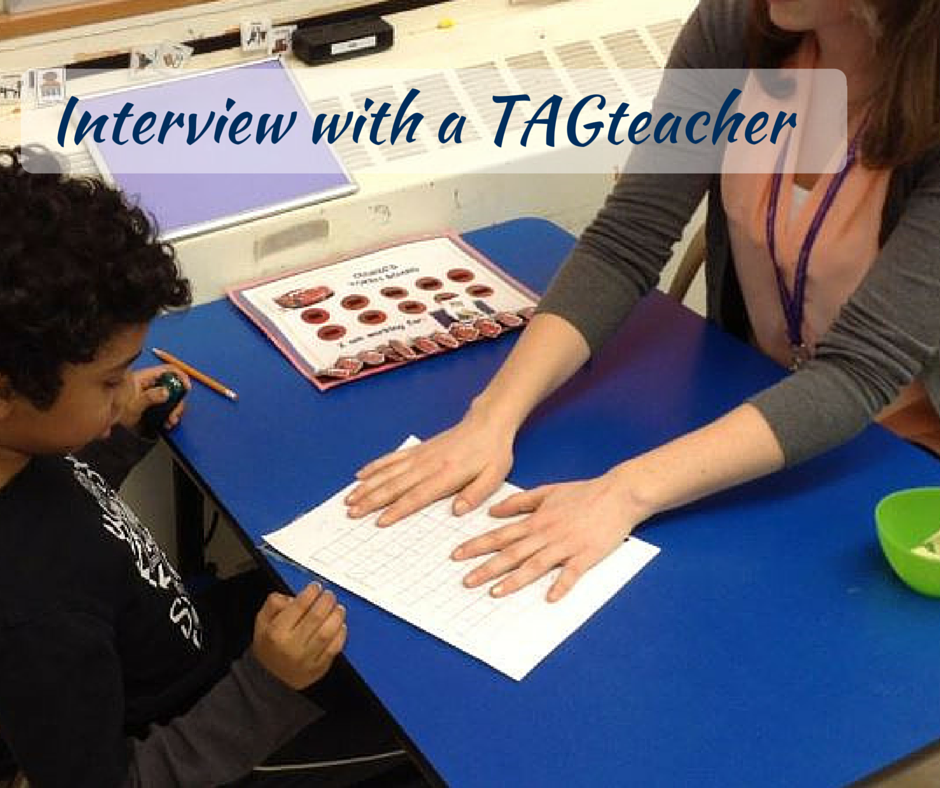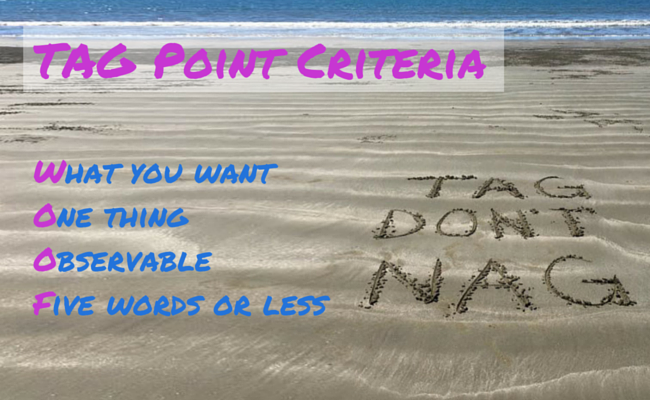This is one of the most frequently asked questions about TAGteach.
Many children with autism have low verbal skills. Not only may they be unable to speak, they may also be unable to endure the sounds of spoken language (like my son); even if they can manage to listen to language, they may be unable to understand and/or follow verbal directions.
These are challenging learners. TAGteach can reach them because the tag and reinforcer communicate where words cannot.
So… let’s say you’re using TAGteach for the first time with a nonverbal child who is flailing about and shrieking. In the midst of this maelstrom of activity, you spot a split second of a desired behavior (let’s say Quiet Mouth) that the child performed and you tag and reinforce that behavior.
How on earth does the child know, in the midst of the chaos, which behavior earned the tag?
The answer has four parts:
First: The sound means good news!
The child notices that the sound of the tag is followed by a nice treat, so the child becomes interested in the sound. Since the sound indicates that something nice (a desired reinforcer) is about to happen, the sound quickly acquires meaning and significance. This learning phase happens quickly. My son figured this out in 25 seconds. “Hmm, that sound is great!”
Second: The child realizes that he causes the tag to happen!
The child notices that his own actions are causing the tag and reward. The tag is not some random, inexplicable event in his environment. The tag is aligned precisely with something he has done, and it’s always followed by a nice treat. This is the big light bulb moment! “Hey, it’s because of something I did!”
Third: The child figures out which behavior resulted in a tag!
How does this child do this part? Since children with autism are hyper-sensitive to their environment, they perceive very quickly when timely information (the tag) and nice reinforcers (the treat) are entering their environment. They use the process of elimination to figure out exactly what they are doing that caused this.
Process of Elimination
“Hmm, I was jumping around and screaming, then I heard the tag and got a nice treat. Was it for jumping up and down? Let me try jumping again; I see: no tag, no treat, so no. Was it for swinging my arms around? Let me try that again: no tag, no treat, so no. Wait, I’m running out of air and want to scream, let me pause and take a breath. Hey, I heard the tag and got a treat. Was it for the pause? Let me try that again: Quiet Mouth, tag! Treat! Yes! It’s Quiet Mouth! Okay, I’ll do more Quiet Mouth! Wow, I’m smart!”
Our kids with autism are brilliant at this. They figure it out quickly, and it’s a thrill for them when they get that big lightbulb moment!
Fourth: The child wants more success and reinforcement, so he continues paying attention to the tag
Like us, kids with autism want success and reinforcement. Once they know how to get it, they will repeat the process, and get to the point where they are looking out for tags and reinforcement and responding quickly.
In a period of often less than fifteen minutes, a nonverbal child can learn that:
- The tag means success
- He performed a productive behavior
- He knows what that behavior is
- It’s worthwhile to perform that behavior again
At this point, the stage is set for teaching all kinds of functional behaviors. It’s also set for communicating and interacting with a child on a personal level. The child performs behaviors, the adults respond with tags and reinforcers, and the child experiences success. The child builds trust in his environment and starts trying out new behaviors; the adults respond patiently with more information (tags) and reinforcement.
The child is not the only one experiencing reinforcement; the adults wielding the tagger are also experiencing massive reinforcement and empowerment! The adults realize that they can do it! They can change the child’s behavior and can help that child learn useful skills. This is the powerful upward spiral of learning and reinforcement that TAGteach delivers.
The cycle of success builds and expands.
 What is TAGteach?
What is TAGteach?
TAGteach stands for Teaching with Acoustical Guidance. TAGteach is a teaching and communication method based on the scientific principles of Applied Behavior Analysis (ABA).
TAGteach enables extremely precise positive reinforcement of behavior by using an acoustical signal to “mark” a behavior – at the precise moment the child performs the behavior! The acoustical signal is a short, sharp sound made by a handheld device (the “tagger”). When the child performs the correct action, the parent/instructor immediately presses the button on the tagger and hands over a treat (candy, treat, token, praise, social recognition, or money) as a reinforcer.
Learn More About Martha and TAGteach
With TAGteach, it is easy to reinforce behaviors precisely and quickly. The immediate, accurate feedback and positive reinforcement result in the child performing the correct action more often, and for longer periods of time. With immediate feedback and learning tasks broken down into small steps, children (and adults) can learn many new skills with TAGteach — at their own pace.
For more information visit the TAGteach website
For research on TAGteach, please see the TAGteach Reference List
Join the free TAGteach For Learning and Behavior Facebook group here
See Martha’s book about TAGteach for Autism or feel free to ask me a question (with no obligation).
Click the button below to sign up for my mailing list and receive updates, new articles and free tips right in your inbox!
If you liked this post, please share it. Thank you!








